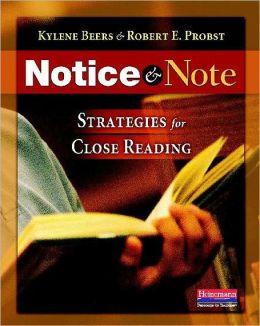A few days ago, I posted about a passage I found to connect to "The Tell-Tale Heart." I was excited about the prospect of the piece, but in my rush to incorporate it into class, I had not thoroughly processed the potential - at least not until waking up in the wee hours of the morning.
My new favorite book (Don't I say that about every book?) for reading comprehension strategies is Notice & Note by Kylene Beers and Bob Probst. The strategies are almost so simple, one wonders why one didn't think of it on her own (her being me).
With my midnight genius, I realized that "The Horror" is a perfect piece to introduce the signpost Contrast & Contradictions, especially as a contrast piece itself to "The Tell-Tale Heart." I already had my presentation for this strategy created, and a first period conference time allowed me to do some quick editing and revising to teach this concept today.
The idea behind the strategy (and the others in the book) is for students to look for repetitive patterns to help understand text. With Contrasts & Contradictions, the kids look for (notice) character actions that are the opposite of what we expect.
We began the lesson by discussing the concepts in the slide - everything from the stop sign, what notice and note mean, and examples of contrasts and contradictions. Now, as an edutainer, I have no problem making fun of myself, so coming up with real-life examples to teach this was easy:
- If Ms. Foti came to school in a dress, you would be asking... (this is where they all chime in with, "Why?").
- If Ms. Foti was mean to you for a day, you would be asking...
- If Ms. Foti got married this weekend, you would be asking...
Hook, line, and sinker, all in one.
Before reading the piece, I set the mood. I turned the lights off (I have a big window). I got everyone quiet. I reminded them that we were focused on identifying contrasts and contradictions within the reading. Then I read "The Horror" as if it was the scariest, most frightening, terrifying work ever written.
I didn't even have to teach after that. Each class period, the kids were already commenting about everything that was "not right" with the passage. The contrasts and contradictions stood out like me in a dress (for those readers who do not know me personally, I am a bit of a tomboy and do not even own a dress). Of course, we did discuss afterward, identifying and labeling (noting) the CCs. But I would not call what I had to do at that point work. It certainly helps to have middle school students who are horror movie connoisseurs.
I have to give a genius student credit for pointing out an obvious CC that I completely overlooked. At the beginning of the text, Eggers sets up Sandra as fearful, yet by age thirty, she is ready to write a horror novel. Can Ms. Foti say contradiction?
It always feels fantastic when students grasp a concept (and quickly), but the best reward is watching them enjoy education. Today ranks as one of the best learning days of the year.


Thank you for your feedback.
ReplyDeleteHi. Is this text appropriate for 5 th graders? Do you have any texts you can suggest if it isn't age appropriate for my kiddos?
ReplyDeleteI have only taught middle school, so I cannot say what is or is not appropriate for fifth graders. This is, however, a story of murder and dismemberment. Probably not the best choice. Your district and colleagues should have curriculum suggestions for your age group.
DeleteThe Horror link isn't working. What is this text?
ReplyDeleteIt appears that it has been removed. You can find the copy I typed here: https://docs.google.com/document/d/1zv-v7T6E8nVyQRPQ4yIYFwWRG7llCLqW5lxJj0cRaHQ/edit?usp=sharing
DeleteWas this the entire lesson? How long have you been working on CC?
ReplyDeleteI posted what we did in class. I have had NN for two years, but I do not use it often. My eighth graders struggle with it. I have not yet found a way to teach it that is working with them.
DeleteI just came across your blog and have been enjoying reading it. Always great to get a peek into another teacher's classroom. Just curious to know if you've been able to get to a point where your kids are "getting" CC. I just started teaching it to my sixth graders last week and it seems like they get it when we read together, but many are struggling when it comes to their independent reading. P.S. How cool that Kylene Beers paid you such a nice compliment!
DeleteUnfortunately, I am not able to use this as often as I would like. We have had some new programs and initiatives district-wide, and this has been pushed to the wayside. I am much more likely to address it again while teaching a novel later in the year.
DeleteI will say that no matter what the concept, kids seem to struggle when it comes to independent work. I am not sure kids understand characterization well enough to be proficient at CC on their own.
How do you teach your lessons? We use an I Do - We Do - You Do method. During the We Do phase, I have the kids work with me first, then I have them work together in groups (still a We situation) with assistance from me. I do not hand them over to independent work until we have gone through all of these phases.